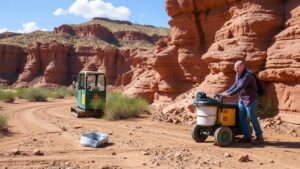Using Heavy Rain Events to Find Newly Deposited Gold Layers
Using Heavy Rain Events to Find Newly Deposited Gold Layers
Heavy rain events can significantly influence geological processes and are increasingly recognized as salient factors in gold exploration. This article explores how such precipitation events can lead to the deposition of gold layers, and how prospectors can utilize this natural phenomenon to their advantage.
The Connection Between Rainfall and Gold Deposits
Gold is often found in alluvial deposits, where it has been transported and concentrated by natural erosional processes. Heavy rain can accelerate these processes in several ways:
- Increased erosion: Intense rainfall can lead to soil saturation, causing landslides or increased runoff, which may uncover buried gold deposits.
- Hydraulic sorting: Fast-moving water can sort sediments by size and weight, effectively concentrating heavier materials like gold.
- Fluvial transport: During heavy rainfall, rivers can swell, transporting gold particles from upstream deposits into new areas.
Real-World Applications and Case Studies
Several documented cases illustrate the relationship between heavy rain and gold deposition:
- California Gold Rush (1849): The discovery of gold in California was partly attributed to heavy rainfall which eroded riverbanks and revealed gold nuggets in streambeds.
- The Klondike Gold Rush (1896-1899): Unusually heavy rainfall led to the flooding of streams, which subsequently deposited new gold layers in easily accessible areas near Dawson City.
- Australian Goldfields: In modern times, prospectors in regions like Western Australia have reported spikes in gold discovery following significant rainfall. A notable example is the Fosterville Gold Mine, which experienced a dramatic increase in gold deposits after major rain events.
Statistical Insights and Patterns
Data analysis shows a correlation between heavy rainfall and increased gold recovery rates. According to research conducted by the Geological Society of America, sites that experienced heavy rain before excavation showed up to a 30% increase in gold yield compared to dry conditions.
Plus, remote sensing technologies have allowed researchers to track topographical changes pre- and post-rainfall, providing valuable insights into optimal searching locations for gold prospectors. This method has been effectively used in the Amazon basin, where seasonal rains reveal new gold sites.
Strategies for Gold Prospectors
To maximize success when utilizing heavy rain events in gold exploration, prospectors should consider the following strategies:
- Timing is Crucial: Monitor weather forecasts for heavy rainfall events, as these could indicate prime conditions for gold discovery.
- Field Surveys: Conduct surveys in areas affected by heavy rain, especially near river mouths or alluvial plains where sediment accumulation occurs.
- Utilization of Technology: Employ drone and satellite imagery to assess post-rainfall landscape changes that may indicate new deposits.
Challenges and Considerations
While heavy rainfall can aid in gold exploration, it also poses challenges, such as:
- Increased Hazards: Flooding and landslides can create dangerous conditions for prospectors, requiring careful planning and safety measures.
- Environmental Regulations: Prospecting activities in river systems are often regulated to protect ecosystems, necessitating compliance with legal frameworks.
Conclusion
Heavy rain events play a crucial role in the natural processes of gold deposition. By understanding the relationship between erosional forces and sediment transport, prospectors can strategically target areas with higher potential for newly deposited gold layers. With advanced techniques and a proactive approach to weather patterns, gold hunters can improve their likelihood of discovery while being mindful of the environmental considerations that come with such activities.
Incorporating these insights will not only enhance gold recovery efforts but may also contribute to more sustainable and responsible prospecting practices in the future.


